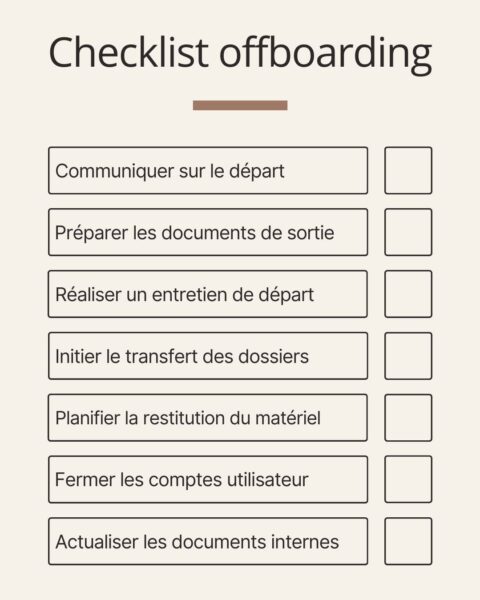Offboarding or outboarding? The two terms cover the same reality. Companies recruit and integrate their employees, but they also have to deal with departures. The departure of an employee can have a considerable impact on their organisation and performance if it is badly managed. So how do you go about off-boarding successfully? Sandrine Lejemble, an expert in human resources and organisational management, takes a closer look.

Departures are part of the "normal life" of a company. There is always a beginning and an end to an employment contract, whether it is a fixed-term or permanent contract. Providing a framework for offboarding, also known as outboarding, is a necessity whatever the context of the departure, even if some call for greater vigilance. We are thinking in particular of resignations linked to dissatisfaction, for example where there is a discrepancy between the job offer and the reality of the assignments. Vigilance is also required in the case of redundancy or contractual termination linked to a disagreement between the employee and the company.
Managing a sharp rise in departures
The resignation rate reached 2.7 % in France in the 1er quarter of 2022, according to a recent Dares study. It's at its highest level since the 2008 financial crisis! It's the "Grand Mercato", according to specialist recruitment agency Robert Half. According to its survey What the candidates want (March 2022)At 77 %, would-be employees are primarily looking for a better salary. They are also looking for a better work/life balance and a closer geographical proximity between home and work. So it's a good time to be leaving, with the departures of some leading to opportunities for others...
"At the end of 2021 and beginning of 2022, the number of resignations will reach an all-time high. [...]
Source: La France vit-elle une "Grande démission" ? - Dares - October 2022
The previous record was set on 1er quarter 2008".
These departures are not without consequences for companies. Not only do they have to maintain activity, but they also have to manage the employee's departure in coordination with the team in place. In other words, off-boarding the employee.
Why is off-boarding an essential skill in HR practices?
Firstly, offboarding makes it easier to manage departures from a technical point of view. In other words, the administrative exit of staff. But it is also, and above all, a prerequisite for the continuation of projects, and even of the business. Finally, it is an extension of the employer brand.
Ensuring business continuity
Offboarding is the best way to ensure that core business activities and skills are passed on. Without offboarding, the major risk is that the company's business will deteriorate. How can projects, or even the business, continue if the core skills and files are not transferred?
On the one hand, teams will be affected: absenteeism, workload, disorganisation, reduced motivation and commitment, and a poorer social climate.
On the other hand, without a follow-up interview about the job and the tasks involved, how can you draw up a job advert that is as close as possible to the reality on the ground? Doing without offboarding means running the risk of falling behind in recruitment. By failing to plan ahead, the company misses out on the transition between the departing employee and the new recruit.
Convey a good image of the company
A succession of poorly managed departures can disrupt your employer brand. Without offboarding, the main risk is to give the company a bad image. For example, once an employee has announced his or her departure, there is no follow-up. They are simply "put aside" for the duration of their notice period.
In this age of social networking, not to mention company review sites, ex-employees who feel discredited or even dissatisfied can easily relay the bad practices they experienced when they left.
Developing your appeal
In a tight employment market, neglecting off-boarding can lead to increased recruitment difficulties. And that means long-term vacancies.
On the contrary, with off-boarding, you ensure a quality employee experience from joining to leaving the company. Well-managed departures contribute to your attractiveness.
[ Read also ]
Would you like to initiate or optimise your offboarding process? Here are the key steps you need to take to define and implement a successful action plan!
The fundamental principles of the offboarding action plan
Offboarding is steered by the company's management and the human resources department. Team leaders take part as part of their managerial role in organising the activity.
1. Take into account the employee's career within the company
Since joining the company - also known as on boarding - At the offboarding stage, the employee has gone through a number of different stages. Has their position, duties or mission changed? Perhaps they've held different positions, or even been promoted?
The aim here is to take account of the employee's career within the company to ensure that he or she is properly separated.
2. Giving thanks, showing appreciation in front of others
Pay tribute to your contribution to the company, and focus on the success of a particular project. This initiative creates a convivial atmosphere and maintains team dynamics in a context of change.
3. Staying on good terms
It's an opportunity to keep in touch as part of a shared professional network. All the more so if the people involved enjoyed working together. In this case, HR can envisage future cooperation, with the former employee acting as a service provider. Or even keep the door open with a view to recruiting him again if the need arises, because he has key expertise. This is known as boomerang recruitment. This is a fairly common practice in certain sectors or professions, such as the press, publishing or IT.

Concrete actions in the offboarding action plan
1. Identify potential departures from the company
Every two years, the professional interview is an opportunity to take stock of the employee's career plans. During this interview, the manager looks at the feasibility of the employee's project within the company. The idea here is to build loyalty. If it's a question of professional retraining, it's a good idea to listen to the employee's approach and work out with him the possibilities for transferring skills. The aim here is to capitalise on their experience.
But, on a day-to-day basis, it also means paying attention to employee motivation and commitment. In particular, to spot any changes in behaviour and to be able to support them.
2. Facilitating the transmission of files
The employee's tasks contribute to the company's development. That's why the manager needs to take stock of the projects and their progress. This enables them to anticipate the impact of the departure on the organisation of their department and therefore to prepare for the handover.
Important points to remind managers
- First of all, you need to anticipate this action sufficiently to carry it out under the right conditions. So it's best to start worrying about it as soon as you've announced your departure!
- Next, involve the employees concerned, either individually or collectively.
- Then, formalise the know-how in shared working documents.
- Lastly, follow-up. In other words, taking stock of the issues dealt with, the skills and methods passed on...
3. Preventing and defusing conflict
Two best practices in offboarding
The first is to communicate transparently. This communication comes firstly from the managers to the team, and secondly from HR to the company. This helps to avoid rumours about the reasons for the departure. And so maintain a good social climate within the team and the company.
The second is to be attentive to the weak signals that suggest disagreement. Depending on the personality, this may manifest itself in impatience, a brusque tone or, on the contrary, a certain nonchalance, or even radio silence. In practical terms, this means that the manager must be a good listener, available for dialogue. They can also remind people that in the event of disagreement, it is also possible to leave on good terms.
4. Conduct a qualitative exit interview
Depending on the size or configuration of the company, the managing director or human resources manager will interview the departing employee to review the working environment, working methods and relations with teams and customers.
You can then get their feedback. What did they like? What do they think could be improved?
This interview can help to develop professional practices, including by building on what is already working well in the company.
In this sense, offboarding has its place in a continuous improvement approach!
5. Recruiting and facilitating professional mobility
From an HR point of view, the risk is of trying to recruit the same profile with a long experience in the company. A rare pearl that's hard to find.
However, the departing employee knows his or her job well. An interview focused on defining recruitment needs is therefore an opportunity to ask them about changes in their job, key skills and skills that are gradually being acquired. In this way, they will help you to define your recruitment needs and the business bridges that will facilitate internal mobility.
It's also a way of recognising expertise and valuing employees.
6. Organising your departure from an administrative point of view
All exit documents must be given to the employee as soon as possible.
The company will schedule the return of the equipment and the closure of the user accounts for the IT tools on the last day.
You can rely on offboarding checklist as for the onboarding checklist.

To sum up, what is successful offboarding? First and foremost, it means maintaining a quality relationship with the employee until he or she leaves. It also means considering and recognising their career path. Finally, it means involving the employee in the transfer of skills, so that succession planning can be carried out internally or externally.


